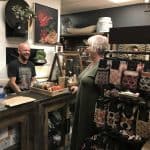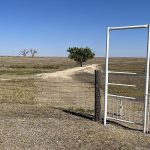
Locavesting: The Revolution in Local Investing. Now required reading for rural economic developers. Photo by Becky McCray.
What if we could change investing from a gamble in the stock market into a local development tool? That’s the basic question behind Amy Cortese’s book “Locavesting: The Revolution in Local Investing and How to Profit From It.”
This book does a great job of explaining the problems in the current financial system, and laying out the alternatives that are being tried. Cortese talks about the revolution in innovative financing plans like royalty financing and alternative business models like cooperatives. Each one includes an explanation, examples of who is using it, and where to find more information.
Community development loan funds and venture funds exist in most states and are a good option for small businesses that cannot get reasonable bank loans. (To find one near you, try cdfi.org). If you’re a sustainable food or agriculture-related business, look for your nearest Slow Money chapter. Some areas have a local investment club or an active angel network. And “crowdfunding” web sites such as Kiva, Kickstarter, ProFounder, and Prosper all offer ways to ways for entrepreneurs to raise funds. Also, many businesses that fill a need in a community—whether for a bookstore or café—have found that their neighbors are often more than willing to invest in the venture. A number of restaurants, for example, have pre-sold meals as a way to raise capital. Others have borrowed money from customers. Finally, if your capital needs are high and you have a good following (and don’t mind giving up some ownership), consider selling shares through a direct public offering, which is a less expensive, “do-it-yourself” version of an IPO.
Several of the tools, like regional stock exchanges, work best when an entire region bands together. But rural regions have a notoriously hard time working together. Is this a realistic goal?
I think that will vary. But state-wide stock exchanges I believe are a workable idea. When financing is confined to one state, federal securities regulations are often superceded by state regulations. That simplifies the process for companies based in a particular state to raise money from residents—the way Ben& Jerry’s did when they raised their first round of funding in Vermont in 1984. (The company went public in an IPO the following year).
What steps can rural and small town economic developers take to support more local investing?
There is a sea change in thinking in economic development policy. Rather than trying lure in the ‘big game’ — in other words, a large factory or big-box store—with taxpayer giveaways, many economic planners are realizing that if they help their homegrown small businesses grow and expand, they can create jobs and boost tax revenues without being dependent on a single employer that might move on to greener pastures. Public-private partnerships and innovative incubator-type programs are being successfully tried across the country. New York City is not exactly rural, but it has created an interesting program to boost the city’s growing ranks of food entrepreneurs with a $10 million fund (funded by Goldman Sachs and the city) that lends to small food manufacturers. You could imagine adding a community-funded option onto that. In Ohio, the Economic and Community Development Institute is launching an Invest Local Ohio program that lets Central Ohians put money in a fund that makes loans to the area’s small businesses, and receive a modest fixed return.
Chapter 2 sounds like a trashing of the financial sector. Do you mean it to be?
Well, I wouldn’t say “trashing.” But I’m certainly not the first to point out that the financial system has become dysfunctional. Wall Street would rather chase trading profits and lucrative derivatives markets than engage in the kind of productive capital raising that was once its mainstay. And that sort of risky finance has brought us to the brink of collapse. The financial sector is doing a lousy job of allocating capital to productive use – when 99% of all the money flying around the stock market goes to trading and speculation, and an ever shrinking fraction goes to funding companies, that is a problem. And the megabanks that dominate the market now are not well suited for small business lending. So many small but worthy companies are falling through the cracks. And let’s not forget that small businesses create 2 out of every 3 jobs in this country.
How do we balance the need for more open financing for small business, against the need for investor protection?
That is a valid concern. But I think we have erred on the side of caution to the point where we have cut off a huge pool of potential capital for small companies, and have prevented individuals from investing in companies they know and trust. The world has changed a lot since the 1930s when our regulatory framework was put into place. Today, information is much more freely available, and investors are able to vet companies in ways that they could not imagine 80 years ago. It’s a little crazy that you can gamble away all of your savings in a casino in Las Vegas—or on the stock market, for that matter—but you can’t easily put money in a private company that is familiar to you and that you believe has good prospects.










